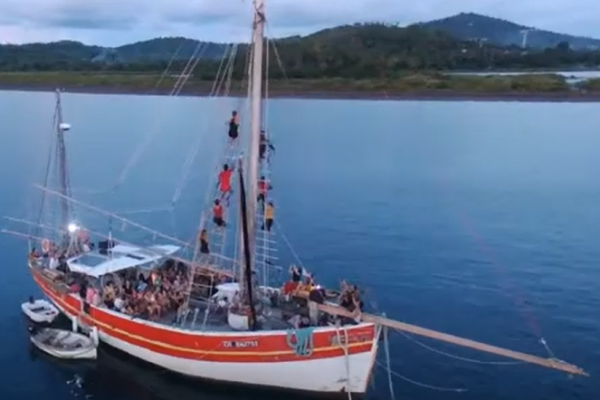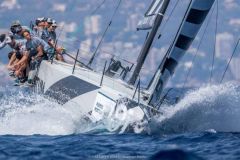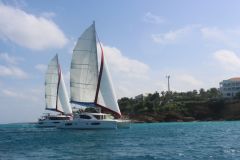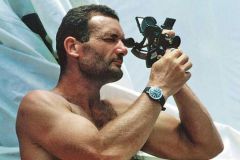Founded in 2013, Compagnie Rêvons l'Envers was born out of a desire to explore new artistic frontiers. Their performances on hoop and aerial fabric aboard a sailboat in Mayotte brought a singular expressive dimension to the art of acrobatics. Pauline Quéméner, a member of the group who has practiced rhythmic gymnastics at a high level for 15 years, shares her experience and the challenges she has encountered.
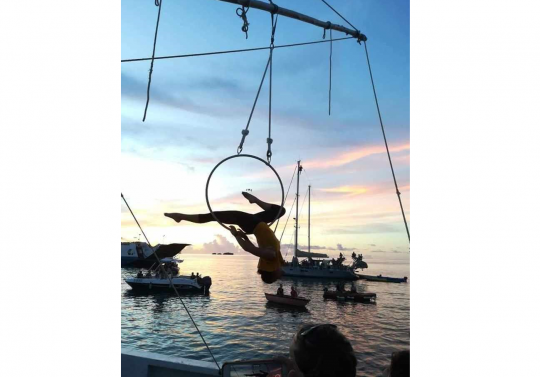
How did you come up with the idea of combining acrobatics and aerobatics aboard a sailboat?
The aim of our basic show, "Wassi Oukou", was to perform several times in Mayotte outdoors, in different locations, to create events, and why not participate in a festival in Madagascar, which was actually the case. After two years on the island of Mayotte, the contacts and encounters became numerous! For my part, alongside my aerial fabric practice, I had a lot of fun on the water thanks to kitesurfing, surfing and sailing. A group of us went to the Petite-Terre sailing school. It was there that we met Nicolas, who was president of the sailing association. He owned a magnificent sailboat, the "Mzouazia", inspired by a lobster boat, which took him ten years to build on his own. Then an idea popped into my head: I'd already seen an aerial fabric show at an old-rigger festival in Paimpol, and found it very beautiful. Clémence and Mary-No, the pioneers of the aerial fabric association in Mayotte, had also mentioned the idea. Knowing Nicolas, I was able to act as a go-between for an on-board show we called "Hisse et Ô".
Can you tell us about the aerial tissue exercise?
Aerial tissu is a demanding circus discipline requiring strength, technique and flexibility. It consists of performing a series of figures suspended from a fabric at a height ranging from 4 to 10 meters. If you're afraid of heights, I wouldn't recommend it! The fabric is almost 18 metres long. The sequences can be performed solo, as a duo or even as a trio, sometimes with quite spectacular falls. It's essential to master the ascent process, wrapping the fabric around one foot and locking it with the other, then pulling with your arms to reach the top. It's a bit like pulling yourself up a flagpole or a coconut tree! Once you've got the hang of it, you don't think about it and it comes naturally. Then you have to learn how to make safety keys, which are essential for performing acrobatic figures.
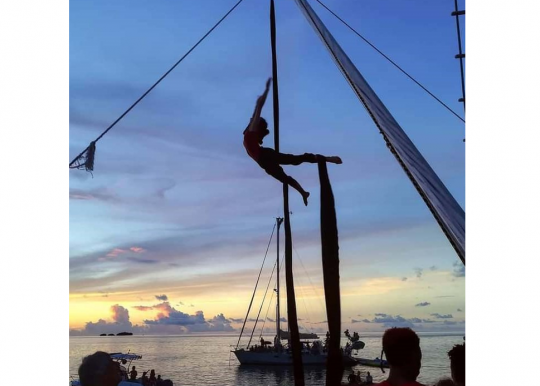
How do you go about selecting venues and times for your performances?
Although my teammates had performed a crane-suspended show before, this was a first for the whole team. Nicolas acted as a guide, with precise knowledge of his sailboat, to show us where to hang the fabrics ideally and where to place the hoop strategically. The boom proved to be the perfect solution for a graceful performance above the water. We opted for a sunset performance at anchor. The weather is generally ideal in Mayotte! However, there was one challenge: the wind. The acrobatics and manipulations in the fabric became more complex, and we had to be careful that the fabric didn't blow away.
Can you tell us about the specific adjustments you had to make to your performances to adapt them to a maritime environment?
On board the boat, it was obvious that we couldn't present our show as it was. We had to adapt it by training directly on site, which required a day and an afternoon of preparation before the show. The challenges were numerous, from logistics to equipment management and travel by dinghy. Fortunately, the Atomix association, particularly active in organizing festivals on the island, gave us invaluable support by installing its sound and light equipment on board. We opted not to announce the event officially to avoid the complications associated with authorizations, but word-of-mouth worked rather well! In the end, around a hundred people were on board the Mzouazia, accompanied by a dozen or so boats, paddles and kayaks.
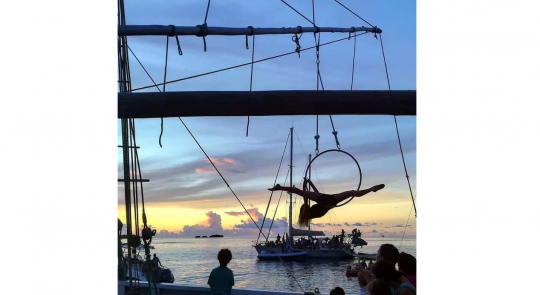
What was the audience's usual reaction when you performed aboard a sailboat?
The excitement was palpable for most people, as this was an unusual experience. Unfortunately, some people weren't able to attend, as a lagoon discovery boat could only take ten people to and from the sailboat at a time. It was quite a logistical challenge, and we weren't able to accommodate everyone. Although we tried to set up a pre-registration list at the beginning, it was quickly overtaken by the public's enthusiasm!
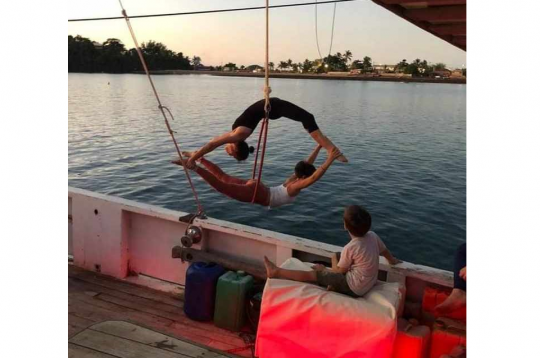
What was the main unforeseen problem you encountered?
This was a totally new experience for me, especially aboard a sailboat. It was a real team effort, prepared in just three weeks. That's why there was inevitably a hitch. We got off to a late start, and it soon got dark. Although there were lights, their illumination was sometimes hampered by the layout of the boats around us, which disrupted visibility. In the end, we were able to continue our acrobatics as long as the sunset was still diffusing its glow: the contrast created a lovely play of shadows on our bodies, adding an extra touch of expressiveness to each of our movements.

In this unexpected encounter, the Compagnie Rêvons l'Envers brilliantly blended aerobatics with the maritime universe, leaving more than one dreamer charmed aboard the Mzouadzia. Their show "Hisse et Ô" is proof that audacity and adaptation can overcome constraints to offer an artistic experience that finds expression both on land and above water.
https://www.youtube.com/watch?v=crVoi00R9gg